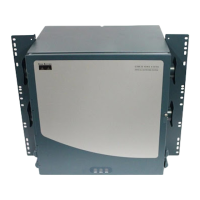15-9
Cisco ONS 15454 Procedure Guide, R5.0
December 2004
Chapter 15 Maintain the Node
NTP-A300 Viewing the Audit Trail Records
Caution Cisco recommends that you save the node database to safe location if you will not be restoring the node
using the database provided on the software CD.
Caution To avoid a node IP and secure IP ending up in the same domain after restoring a database, ensure that
the node IP stored in the database differs in domain from that of the node in repeater mode. Also, after
restoring a database, ensure that the node IP and secure IP differ in domain.
Note The following parameters are not backed up and restored when you delete the database and restore the
factory settings: node name, IP address, subnet mask and gateway, and IIOP port. If you change the node
name and then restore a backed up database with a different node name, the circuits map to the new
renamed node. Cisco recommends keeping a record of the old and new node names.
Step 1 If you need to install or replace one or more TCC2/TCC2P cards, see the “DLP-A36 Install the
TCC2/TCC2P Cards” task on page 17-42.
Step 2 If you are using Microsoft Windows, complete the “DLP-A244 Use the Reinitialization Tool to Clear the
Database and Upload Software (Windows)” task on page 19-25.
Step 3 If you are using UNIX, complete the “DLP-A245 Use the Reinitialization Tool to Clear the Database
and Upload Software (UNIX)” task on page 19-27.
Stop. You have completed this procedure.
NTP-A300 Viewing the Audit Trail Records
Step 1 Complete the “DLP-A60 Log into CTC” task on page 17-66 at the node where you want to view the audit
trail log. If you are already logged in, continue with Step 2.
Step 2 In the node view, click the Maintenance > Audit tabs.
Step 3 Click Retrieve.
A window containing the most recent Audit Trail records appears as shown in Figure 15-4.
Purpose This procedure describes how to view Audit Trail records. Audit trail
records are useful for maintaining security, recovering lost transactions, and
enforcing accountability. Accountability refers to tracing user activities;
that is, associating a process or action with a specific user.
Tools/Equipment None
Prerequisite Procedures None
Required/As Needed As needed
Onsite/Remote Onsite or remote
Security Level Provisioning

